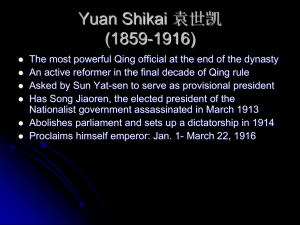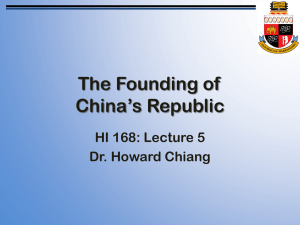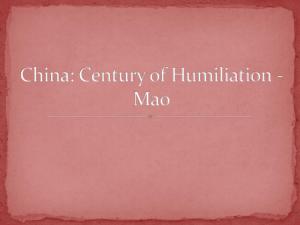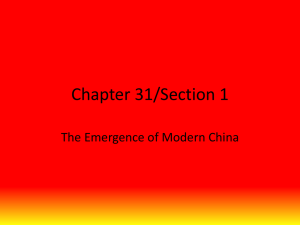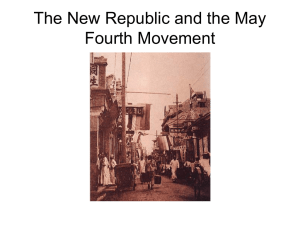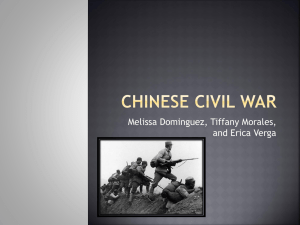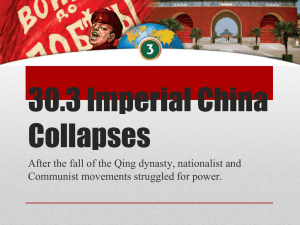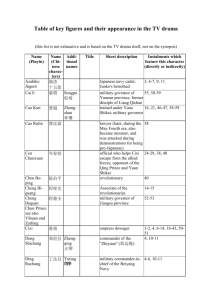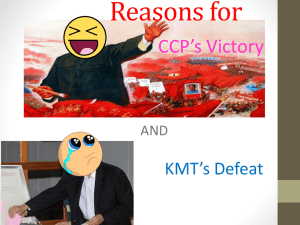Lecture 2 – From Late Qing Dynasty to 1945
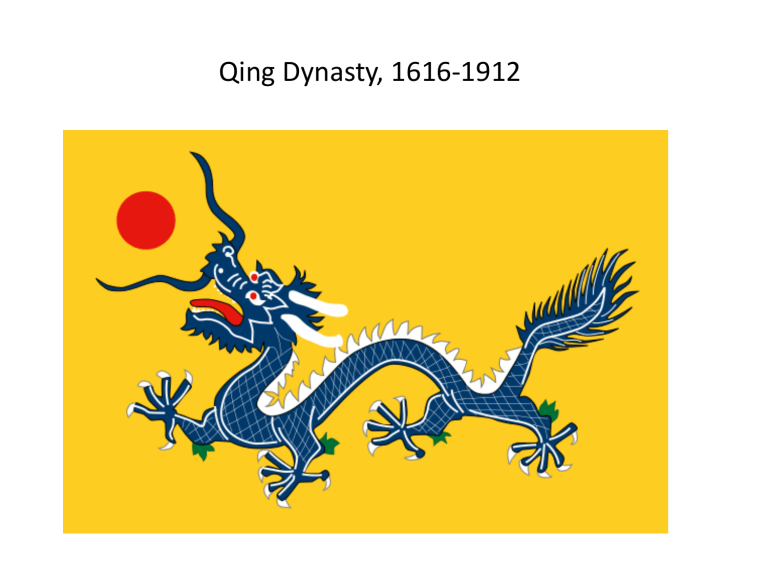
Qing Dynasty, 1616-1912
The Qing Empire in 1890
Qing Dynasty ruled China from 1644-1912.
The Opium Wars, also known as the Anglo-Chinese Wars, divided into the First Opium War from 1839 to 1842 and the Second Opium War from 1856 to 1860. These were the climax of disputes over trade and diplomatic relations between China under the Qing Dynasty and the British
Empire.
The First Sino–Japanese War (1 August 1894 – 17 April
1895) was fought between Qing Dynasty China and Meiji
Japan, primarily over control of Korea.
The Boxer Rebellion, Boxer Uprising or Yihetuan
Movement, was a violent movement by the
Righteous Harmony Society in China between
1897 and 1901. It expressed proto-nationalist sentiments and tried to eradicate opposing foreign imperialism and Christian missions. The
Great Powers (United Kingdoms, Russia, Japan,
France, United States, Italy, Germany, Austria-
Hungary) intervened and defeated the government forces, in a humiliation for China.
The “last emperor” of China Puyi abdicated on
Feb 12, 1912.
The Republic of China was founded in 1912.
The revolution leading to the establishment of the ROC was led by the Chinese Nationalist
Party (KMT). Dr. Sun Yat-sen became the 1 st provisional president of ROC, January 1-March
10, 1912.
Dr. Sun Yat-Sen 孫逸仙
Provisional President of the Republic of China, Jan 1 – March 10, 1912
KMT Emblem
National Flag of the Republic of China
Yuan Shikai succeeded Sun Yat-Sen as the provisional president.
Yuan Shikai was elected as the 1 st president of the
ROC on Oct 10, 1913.
Yuan Shikai decided to restore monarchism, Empire of
China, and declared himself emperor of China, Jan 1 –
March 22, 1916. He dies of kidney failure on June 5,
1916.
After Yuan’s death, his lieutenants split into regional warlords, fighting each other. The Warlord Era lasted from 1916-1928.
Yuan Shikai sworn in as Provisional President of the Republic of China, in Beijing, 10 March 1912.
袁世凱 Yuan Shikai, 1859-1916
The Warlord Era, 1916-1928
During the Warlord Era China had become divided between different military leaders without a proper central government. In 1921 Sun Yat-sen started a self-proclaimed military government in Guangzhou and was elected Grand
Marshal.
By this time Sun had become convinced that the only hope for a unified China lay in a military conquest from his base in the south, followed by a period of political tutelage that would culminate in the transition to democracy ( 军政、训政、宪
政)。
Meanwhile, the Communist Party of China (CPC), also known as the Chinese Communist Party (CCP), was Founded in July
1921 in Shanghai with help from the Communist International.
The First United Front between the KMT and the CCP
In order to hasten the conquest of China, he began a policy of active cooperation with the Communist Party of China (CPC).
Sun and the Soviet Union's Adolph Joffe signed the Sun-Joffe
Manifesto in January 1923. Sun received help from the
Comintern for his acceptance of communist members into his
KMT. Revolutionary and socialist leader Vladimir Lenin praised
Sun and the KMT for their ideology and principles. Lenin praised Sun and his attempts at social reformation, and also congratulated him for fighting foreign Imperialism. Sun also returned the praise, calling him a "great man", and sent his congratulations on the revolution in Russia.
With the Soviet's help, Sun was able to develop the military power needed for the Northern Expedition against the military at the north. He established the
Whampoa Military Academy near Guangzhou with
Chiang Kai-shek as the commandant of the National
Revolutionary Army (NRA). Other Whampoa leaders include Zhou Enlai, Wang Jingwei and Hu Hanmin as political instructors. This full collaboration was called the
First United Front.
Sun Yat-sen (middle, dressed in white) and
Chiang Kai-shek (on stage in uniform) at the founding of the Whampoa Military
Academy in 1924.
Sun Yat-sen died of liver cancer on March 12, 1925.
Northern Expedition, 1926-28
Chiang Kai-shek set out the Northern Expedition in the summer of 1926. NRA forces easily defeated the Zhili armies of Wu Peifu and Sun Chuanfang in central and east China.
Northern Expedition, National Revolutionary Army, July 1926 - 1928
In 1927, the KMT-CCP alliance ruptured with the communists being brutally purged, which initiated the Chinese Civil War.
In 1928, after defeating the warlord armies in the
Northern Expedition, Chiang Kai-shek became the leader of China.
A Nation within A Nation – Two Chinas
CCP established a new nation, the Chinese Soviet Republic, 1931-1937
Retreated in 1934, settled in Yanan in 1936
National_Flag_of_Chinese_Soviet_Republic
One-yuan bill with Vladimir Lenin's image in the centre.
The Second Sino-Japanese War (July 7, 1937 –
September 2, 1945)
The Second United Front was the brief alliance starting in December 1936 between the Chinese Nationalists
Party (Kuomintang, or KMT) and Communist Party of
China (CPC) to resist the Japanese invasion during the
Second Sino-Japanese War, which temporarily suspended the Chinese Civil War.
The Second United Front started to break down by late
1938 because both sides were vying for territorial advantage. http://en.wikipedia.org/wiki/Second_United_Front
Soong Ai-ling 宋霭龄 , Wesleyan College, 1909
Soong Qing-ling 宋庆龄 , Wesleyan College http://www.youtube.com/watch?v=Oy_GjMejpsY
Soong Mei-ling 宋美龄 , Wesleyan College, Wellesley College http://www.youtube.com/watch?v=4t7gYeUrptE http://www.youtube.com/watch?v=61bV9zeCrA&list=WL8BDDAF553C9953CD
The communists under the leadership of Mao
Zedong began to focus most of their energy on building up their sphere of influence wherever opportunities were presented, mainly through rural mass organizations, administrative, land and tax reform measures favoring poor peasants; while the
KMT allocated many divisions of its regular army to carry out military blockade of the CPC areas in an attempt to neutralize the spread of Communist influence until the end of the Second Sino-Japanese
War
Mao Zedong (second from left in a dark uniform) and Communist Party of
China (CPC) officials meeting with United States Ambassador to China,
Patrick Hurley (at center - in bow tie), at CPC headquarters in Yan'an,
1945.
After a lengthy civil war, the CPC defeated its primary rival, the Kuomintang (KMT), and assumed full control of mainland China by 1949. The Kuomintang retreated to the island of Taiwan, where it still remains to this day.
http://www.youtube.com/watch?v=X_2-3Dm730Q
